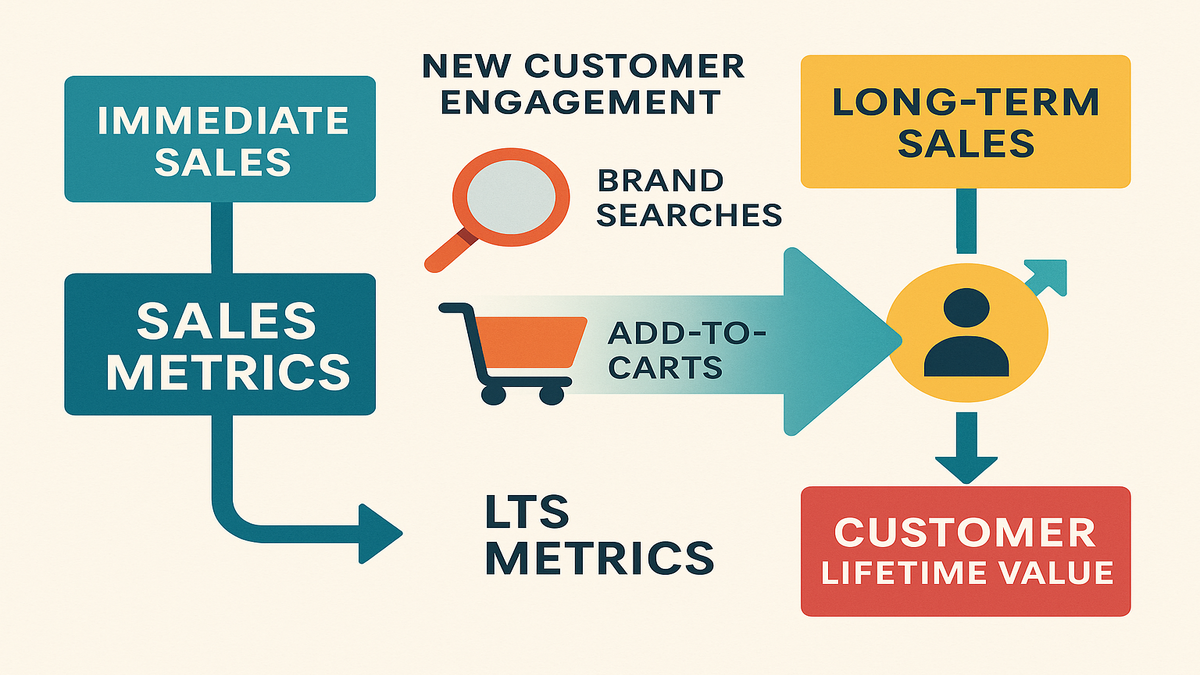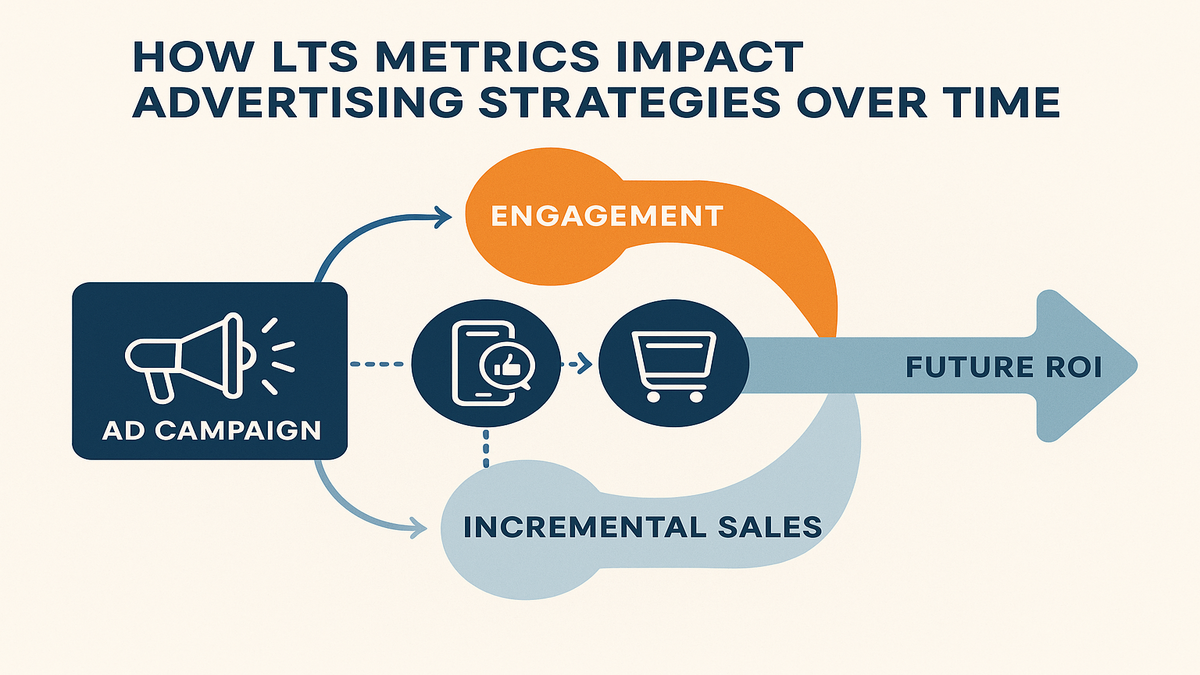
Harnessing Long Term Sales Metrics for Campaign Success

Picture this: You’re running very targeted ad campaigns that generate tons of potential first-time buyers, but the conversion isn’t immediate. You put in so much effort, and then nothing. Before they streamed away to the blackness of sales stats that instant sell out and that no one ever speaks of again. Enter Long Term Sales (LTS) metrics—revolutionary in how you track and measure the progress of your long-term marketing campaign.
Say hello to the new marketing metrics buzzword, LTS and its sidekick, Long Term Sales Return on Ad Spend (LTS ROAS), where they’ll finally show you the real-world fruits of your labour on a 12-month term length as a rise in revenue. And these aren’t all exactly wishy-washy numbers, no sirree. They’re supposed to allow you to see beyond this short-term horizon, and to count the new-to-brand consumers and the incremental sales they delivered.
Now that these capabilities have been released via Amazon’s ad console, advertisers don’t have to be kept in the dark as to the real value their campaigns actually bring to the entire ecosystem. Today, campaign reporting’s brave new world reveals to us much more of what’s actually working — before the paint on those first-blank canvases of engagement has even had a chance to dry.
TL;DR / Key Takeaways
- Gives you a 12m projected view on your ad campaign sales and ROI utilizing LTS and LTS ROAS.
- They keep the gap value of new leads that engage but do not buy on day 1.
- From campaign reports in Amazon’s ad console.
- U.S.-centered at the moment for Sponsored Ads customers but is rolling out global, real-time insights.
- Alters ad spend by assigning credit for those future transactions to the initial engagements.
And for more breakdown on the best ads, head on over to our Features guide on how to play with the numbers.

Understanding Sales Data Over the Long Term
The addition of Long Term Sales (LTS) metrics fundamentally shifts how advertisers measure ad campaign performance. By and large, ad metrics have involved the here and now. But let’s be real, that’s not always the name of the game, huh? Traditional metrics do not account for this long term value of a customer over their lifetime, especially in the context of how a customer is first introduced to a brand. They’re like trying to tell what happens in a movie by watching a trailer.” PPI metrics meet this need by forecasting the incremental sales from new customers based on historical purchase behavior for year 2.
Think of them as a crystal ball showing possible returns on your advertising investment. But if your ad impacts a new-to-brand shopper who makes a purchase weeks or months later, LTS and LTS ROAS will measure that “delayed win.”
These metrics are also what determine how you are supposed to measure a campaign’s success. According to Amazon AdConsole, the reporting works seamlessly with them, and you can get the full picture of which ads return value over time. That means no mores guess horse that don't come out the barn!
Why It Matters: The Effect on Ad Strategy
It’s a problem that advertisers have long struggled with: What is the right value to place on campaigns? You pop the champagne for quick sales triggers, but what about the exchanges that gradually warm their way into that simmer, until it boils over into a buying frenzy? They don’t offer you a photo right there, with standard analytics, so you can see how many valuable views don’t produce the result right away. That was the confusion… until LTS metrics was released!
Those are your golden advertising metrics because that includes the granular page views and add-to-cart events that got you the customer in the end. They show the full customer journey, even when the conversion actually occurs at a later date—This is important to know when it comes features scaling marketing efforts and getting more out of ad spends.
For example, there is a social media ad for a consumer product that intrigues a user, but results in a sale many months in the future. There’s a sense of satisfaction and momentum rewarded, as well as aiding you evolving on the game. “LTS lets ad get a bit of that credit,” said trees.

Real-World Example: Ad Game-Changer
For example, pretend you’re a new ecommerce brand that makes coffee makers. If your ads brought brand new customers who then came back twice and made a purchase a few months afterward, your traffic to purchase conversion is “a few months and a few clicks.” Well, with long-term support (LTS) metrics, you’ve got hard evidence this engagement led to future revenue.
Amazon’s stats arm the run-of-the-mill ad salesperson to fine-tune strategy, rejigger ad-spending priorities and ultimately ratchet up the ROI they can claim. Then use that knowledge to cut through the noise, and figure out which of your customer engagement activities is actually driving the needle – and, dare we say, how to put a little more budget behind those high-impact campaigns that are the most likely to generate long-term value.
In fact, you can get real examples on our Case Studies page, we have real metrics – that have proven to work in a number of industries.
Expert Insight
"These metrics extend the value timeline, acknowledging the fact that not all purchase decisions are immediate," says marketing strategist Ashley Holt. It cements the importance of brand touchpoints in a customer journey.”
Making the Most of Your Campaign
So, you’ve seen the amazingness of LTS and you’re a convert now, huh? But how do you get the most out of them?
- How to access the report: Log into the Amazon Ads Console and then navigate to campaign reporting.
- Incorporate Findings: What do campaign contributions buy in long-term relations?
- Optimize Campaigns: Let the focus on what interactions are worthwhile in the long term and optimize future campaigns.
- Measure Performance: Analyze against 'immediate' vs. 'incremental' sales and perfect your key approach.
Summary: Key Ideas at a Glance
- LTS (Long Term Sales): Amount of sales in excess of previous 12 months' sales.
- New and Returning Customers: New to brand customers and extended conversion path.
- Analytics Integration: Turn on our Ad Console for advanced tracking.
- Strategic Alpha: Tie ad spend back to a measurable future sales opportunity.
- Reach: Focusing on advertisers located in the U.S.
FAQs
1. Long Term Sales and LTS ROAS What areLONG TERM SALES and LTS ROAS? LTS and LTS ROAS are metrics that estimate how advertising campaigns will perform over the long term by predicting incremental sales from new-to-brand customers over 12 months.
2. How are they calculating these numbers? They analyze new customer engagements — things like searches on a branded term, page views and add-to-carts — and estimate the sales that those new engagements could create over the next year.
3. Who can use these metrics? The metrics, which are accessible now for Sponsored Ads advertisers in the U.S., arm those advertisers with information they can use to adjust ad campaign strategies long-term.
4. Why should you be able to know LTS metrics now? LTS metrics help to shed more light on the long-term effects of ad campaigns in order to provide a more accurate overview of the customer lifetime value (CLV) and to gain greater control of your ad spend.
5. What resources do I need to gather these metrics? Amazon Ads Console support for downloadable reports You can download reports from the Amazon Ads Console and merge into your existing campaign management workflow.
Apply LTS to Marketing Plan
- Pre Campaign Data Analysis: Find frequent patterns in the buyer’s behavior to predict high risk sale.
- Shift How You Engage: Look for things that suggest interest rather than low-cost, bothead engagements such as page views and adds-to-cart.
- Double-Down On High-Value Channels: Spend a greater percentage of hay with the channels that historically had given you the highest LTS scores.
- Monitor & Enhance: Implement and optimize approach based on quarterly LTS insights for continual impact.
So with that, down the weeds on these measurements you can go. The world of marketing has been obsessed with the quick fix. But when it comes to Long Term Sales metrics, patience is a virtue. Doing so offers a perspective beyond selfish — as in they dedicate themselves to growing right now and in the future thanks to the benefits of your campaigns.
Take these tips and apply them to your campaign to do the best work for yourself. Check out our complete Amazon Ads Guides for more successful advertising advice.
References
- Amazon Advertising: Long Term Sales Metrics
- Holt, Ashley. “The Longer View: How We Learn About Customers as Time Goes By.” National Marketing Journal: p2013.

